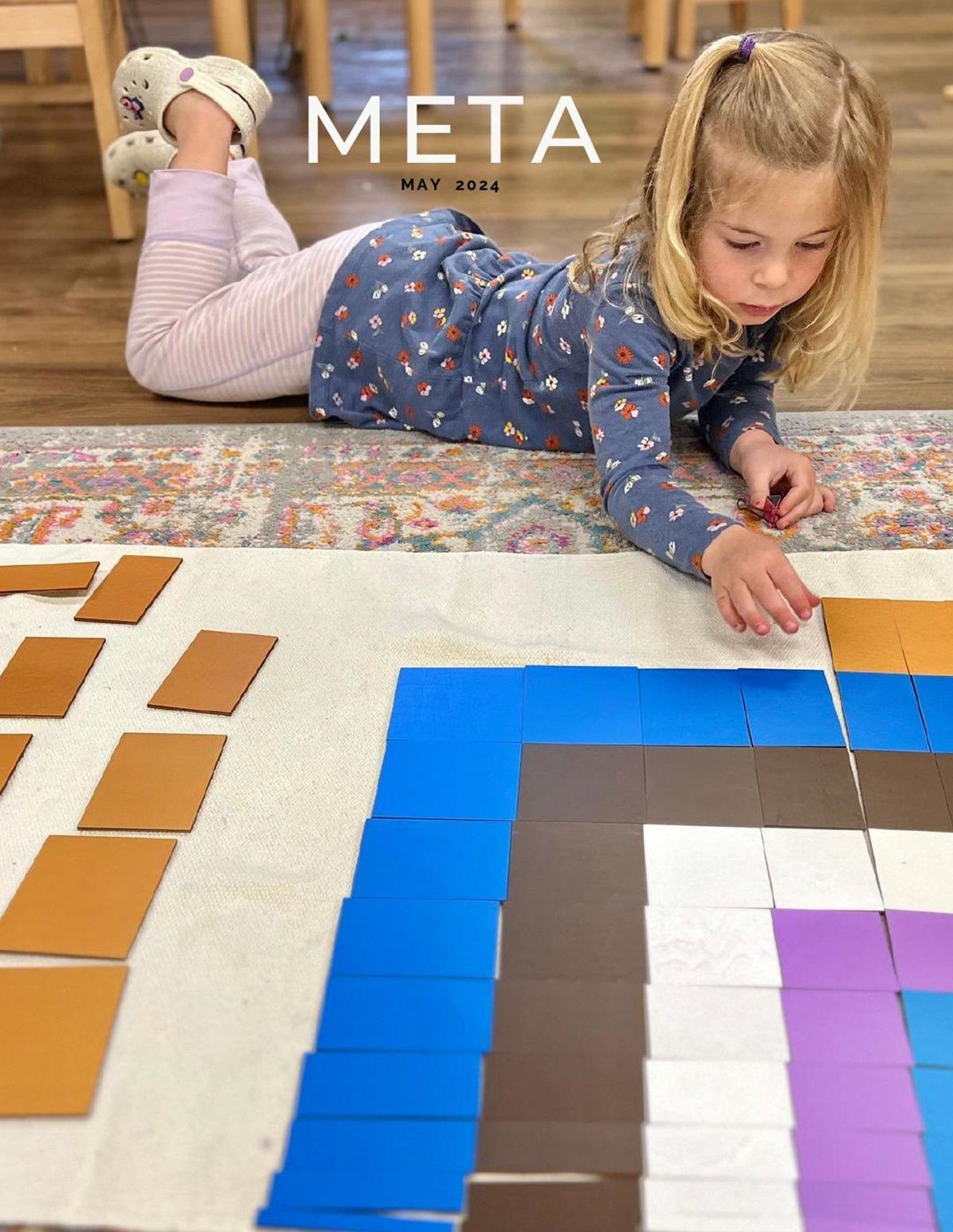Offering the optimal environment for adolescence
As Montessori parents know, developmental tasks change over the course of childhood and adolescence. We follow children and adolescents through the four planes of development, attempting to provide them with a unique prepared environment that meets their specific needs at each stage. The prepared environment provides children and adolescents with the tools they need to do their jobs, which is to become who they are throughout life.
Social development is the main task of adolescents. It is their job. Maria Montessori described adolescents as “new born social being[s]” (Montessori, “Third Lecture” 256), because the work of the adolescent is developing social independence the same way that the work of the young child is developing physical independence. Newborn children gain functional independence in order to be able to interact with their environments, including the people in it, independently. When children reach adolescence, they are prepared to develop social independence by coming to understand how to live independently as contributing members of society.
As busy parents juggling work, volunteer, and home responsibilities, it can be easy to look back at our teenage years with some level of nostalgia. Remember when your biggest concerns were going out with friends, playing for a sports team, or getting a good grade on a test? In other words, your concerns were primarily about you, and only you--maybe a little obsessively about you? But then--you remember the feelings of being a real, live, emotional teenager.
Now imagine you are fourteen, and literally overnight, all of the things you were obsessively concerned about are no longer even a possibility. And on top of it all, you are stuck home. With your parents. Indefinitely. Your only connection to your biggest priorities--your friends--is through a screen. But hey, at least you finally have something in common with all of the adults in your life--a never-ending series of Zoom conference calls and a collective sense of loneliness.
Adolescents are wired to connect socially. According to neuroscientist Sarah Jayne-Blakemore, “the brain develops both structurally and functionally during adolescence. Large-scale structural MRI studies have demonstrated development during adolescence in white matter and grey matter volumes in regions within the social brain.” (Blakemore, March 2012)
That’s what makes social distancing particularly difficult for teenagers. Their brains are driven to develop socially, but they have suddenly lost their means of doing so.
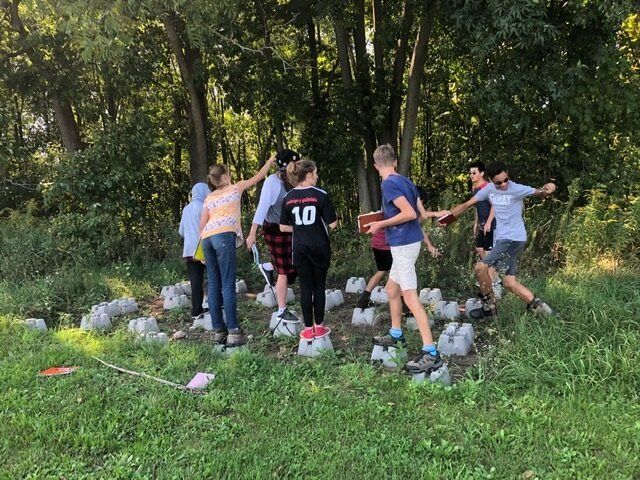
Adolescents are biologically driven to interact with peer groups.
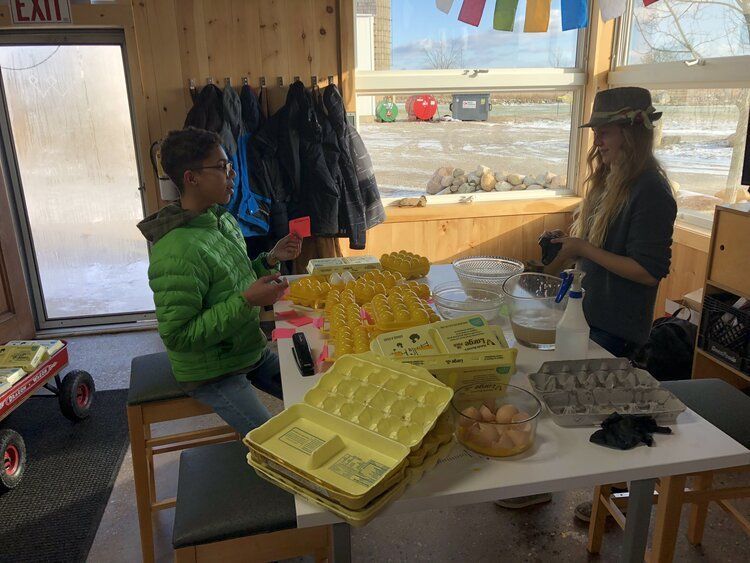
Montessori Farm School students talk while preparing the egg shares for the week. Micro-economies are a hallmark of any Montessori Middle School program.
The importance of physical socialization in the time of COVID-19
Becoming socially independent, of course, requires socializing. Repeated interactions with peers in a social environment allow adolescents to further develop key skills like collaboration, conflict resolution, advocating for oneself, empathy, and intimacy. These skills are essential to their success and happiness as independent adults. All of that “middle school drama” is a necessary condition for successfully navigating adult relationships, both personal and professional, and adolescents need a stage where the drama can be played out.
Unfortunately for everyone right now, technology just can’t fully replace in-person interactions. The functional element of adolescents’ social cognitive development has to do with the concept of “mentalizing.” Blakemore explains, “We are constantly reading each other's actions, gestures and faces in terms of underlying mental states and emotions, in an attempt to figure out what other people are thinking and feeling, and what they are about to do next.” Through the practice of socializing, then, adolescents are learning how to recognize what other people are thinking, how to anticipate their actions based on their underlying emotions, and developing strategies for responding in productive or unproductive ways.
Whew! Not only does that sound like a lot for a teenage brain to take on amidst all of the other physical changes occurring during puberty, but it also sounds like essential development for living a happy, independent adult life.
So, how, exactly, is that sort of development supposed to occur when teens can’t be together? Sure, they can meet online for video chats, texting, and gaming. But, is it really possible to read “each other’s actions, gestures, and faces” with the level of nuance required to discern “underlying mental states and emotions” without the benefit of physical presence?
Neuroscience research comparing fMRI scans of people’s brains while interacting face to face versus via static technology would indicate otherwise. (Redcay, et al, May 2010) Most adults have undoubtedly had the experience of misreading the intention of a text, email, and increasingly, Zoom, communication and responding inappropriately. Now, imagine you are a teenager with a social-brain-in-development. We’re still playing out a middle school drama, but now we’ve thrown out the script.
In addition, there are significant health benefits to meaningful social interaction, which should come into greater focus as we emerge from a global pandemic. According to psychologist Susan Pinker, “Face to face contact releases a whole cascade of neurotransmitters, and like a vaccine, they protect you now in the present and well into the future. So simply making eye contact with somebody, shaking hands, giving somebody a high-five is enough to release oxytocin, which increases your level of trust and it lowers your cortisol levels. So it lowers your stress.” (TED Talk, 2017)
More physical, mental, and emotional development occurs during adolescence than at any other stage of life outside of newborns. And the link between stress, the immune system, and healthy development is becoming increasingly clear. In the midst of the physical upheaval of puberty, adolescents need to be engaged socially, because social interaction in the context of a supportive social community lowers stress levels, thus boosting immunity and encouraging healthy development.
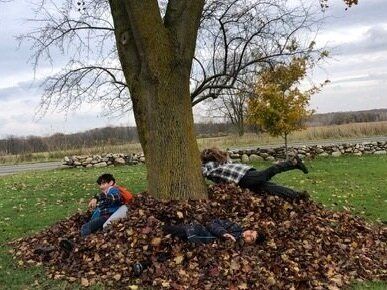
In-person socializing looks vastly different in the brain compared with virtual socializing.
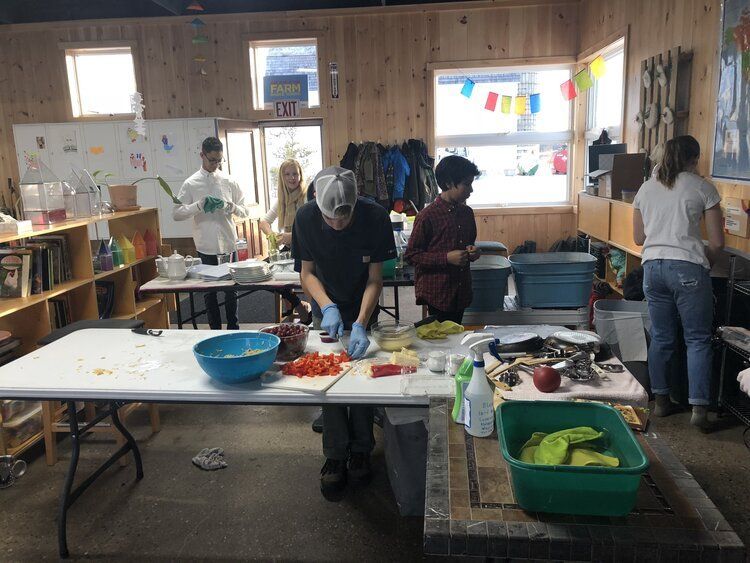
Students prep community lunch every Friday. This pulls together planning, shopping, food preparation and clean up— skills as an aid to life.
What options do parents and students have?
So where does that leave us? As we face the prospect of ongoing social distancing of some sort over the next one to two years, it is more important than ever to consider the needs of developing adolescents in educational program design.
That is why we are so grateful for our community at Stepping Stones. Relative to larger, more traditional schools, interruptions to normal adolescent development are likely to be minimal in our program. With a short-term enrollment goal of 10-15 students and 110-acres to inhabit, we are well poised to be able to continue operations meeting the CDC’s latest recommendations and more with only slight modifications during the next periods of inevitable social distancing. While all the photos you see in this post were taken pre-COVID, our priority will always be to provide as many in-person, social experiences as is deemed safe.
If you are interested to learn more about our
Montessori Middle School at River Ridge Farm, please contact sarahd@steppingstonesgr.org.
References:
Blakemore, Sarah-Jayne, “Development of the social brain in adolescence,” JRSM, March 2012. Retrieved from: https://www.ncbi.nlm.nih.gov/pmc/articles/PMC3308644/
Montessori, Dr. Maria, Third Lecture at Montessori Congress in Oxford, England (1936), as published in “The Erdkinder Research and Development Report,” AMI, 1981
Redcay, Dodell-Feder, Pearrow, Mavros, Kleiner, Gabrieli, Saxe, “Live face-to-face interaction during fMRI: a new tool for social cognitive neuroscience,” NCBI, May 2010. Retrieved from: https://www.ncbi.nlm.nih.gov/pmc/articles/PMC2849986/
Pinker, Susan, “The Secret to Living Longer may be your Social Life”, TED Talk, 2017 Retrieved from: https://www.ted.com/talks/susan_pinker_the_secret_to_living_longer_may_be_your_social_life/transcript?language=en
Umberson, et al, “Social Relationships and Heatlh: A Flashpoint for Health Policy,” NCBI, August 2011. Retrieved from: https://www.ncbi.nlm.nih.gov/pmc/articles/PMC3150158/


